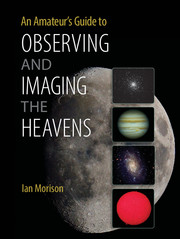Book contents
- Frontmatter
- Dedication
- Contents
- Preface
- Acknowledgements
- Prologue A Tale of Two Scopes
- 1 Telescope and Observing Fundamentals
- 2 Refractors
- 3 Binoculars and Spotting Scopes
- 4 The Newtonian Telescope and Its Derivatives
- 5 The Cassegrain Telescope and Its Derivatives
- 6 Telescope Maintenance, Collimation and Star Testing
- 7 Telescope Accessories
- 8 Telescope Mounts
- 9 The Art of Visual Observing
- 10 Visual Observations of the Moon and Planets
- 11 Imaging the Moon and Planets
- 12 Observing and Imaging the Sun
- 13 Observing and Imaging with an Astro-Video Camera
- 14 DSLR Deep-Sky Imaging
- 15 Imaging with Cooled CCD Cameras
- 16 Auto-Guiding and Drift Scan Alignment
- 17 Spectral Studies
- 18 Improving and Enhancing Images in Photoshop
- Index
- Plate Section
8 - Telescope Mounts
Alt/Az and Equatorial with Their Computerised Variants
Published online by Cambridge University Press: 05 June 2014
- Frontmatter
- Dedication
- Contents
- Preface
- Acknowledgements
- Prologue A Tale of Two Scopes
- 1 Telescope and Observing Fundamentals
- 2 Refractors
- 3 Binoculars and Spotting Scopes
- 4 The Newtonian Telescope and Its Derivatives
- 5 The Cassegrain Telescope and Its Derivatives
- 6 Telescope Maintenance, Collimation and Star Testing
- 7 Telescope Accessories
- 8 Telescope Mounts
- 9 The Art of Visual Observing
- 10 Visual Observations of the Moon and Planets
- 11 Imaging the Moon and Planets
- 12 Observing and Imaging the Sun
- 13 Observing and Imaging with an Astro-Video Camera
- 14 DSLR Deep-Sky Imaging
- 15 Imaging with Cooled CCD Cameras
- 16 Auto-Guiding and Drift Scan Alignment
- 17 Spectral Studies
- 18 Improving and Enhancing Images in Photoshop
- Index
- Plate Section
Summary
No telescope can be used sensibly unless it is supported by a mount which is sufficiently sturdy to hold it steady. This is an obvious statement, but many mounts supplied with less expensive telescopes are not really up to the task. Often the tripod supports are so light that, when one attempts to move the telescope, the tripod moves! (The solution to this problem is to fill the tripod legs with sand.) As telescope apertures increase, it may well be that the cost of a suitable mount will exceed that of the telescope tube assembly, but this is a price worth paying as a poor mount will cause one endless frustration when observing. A really solid mount is of prime importance for astro-imaging, and some authors state that one should halve the nominal load capacity of a mount for this use. Many telescopes at the lower end of the price range are sold only as a package with an included mount, but for more expensive refractors or reflectors, the tube assembly can usually be bought separately and the user can chose a suitable mount.
Mounts come in two basic types: altitude/azimuth (Alt/Az) or equatorial. Before the advent of computer-controlled drive systems, most mounts were equatorial. The reason was simple. Once an equatorial mount has been aligned on a star, drive − at a fixed sidereal rate − need be applied to only one axis to track it across the sky. Thus a simple electronic controller, based on a crystal oscillator to give an accurate time base, could be used. In contrast, the Alt/Az mounts have to be driven in two axes at variable rates in order to track. For example, when a star is rising in the east, the altitude drive rate will be quite high whilst the azimuth drive rate will be fairly low, but as the star crosses the meridian, due south, the azimuth rate will be high but the altitude rate will be zero and will change from a positive rate whilst the star was rising to a negative one whilst it is setting.
- Type
- Chapter
- Information
- An Amateur's Guide to Observing and Imaging the Heavens , pp. 119 - 138Publisher: Cambridge University PressPrint publication year: 2014



